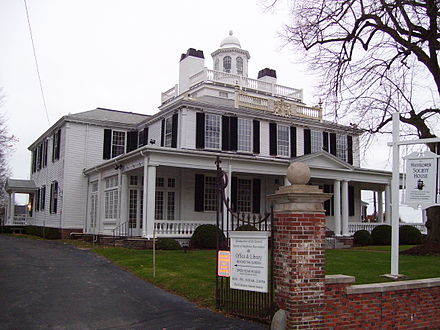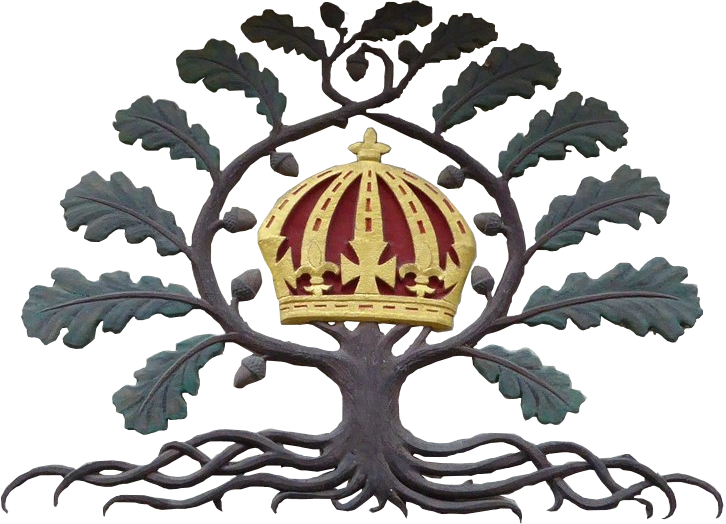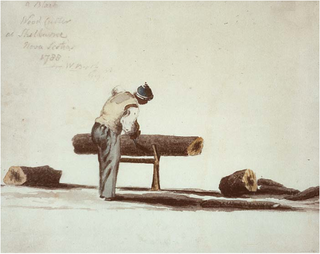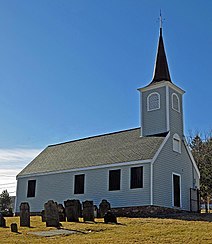
The Mayflower House Museum is an 18th-century period historic house museum in Plymouth, Massachusetts operated by The Mayflower Society, also known as the General Society of Mayflower Descendants. The Society purchased the Edward Winslow House in 1941.
A historic house museum is a house that has been transformed into a museum. Historic furnishings may be displayed in a way that reflects their original placement and usage in a home. Historic house museums are held to a variety of standards, including those of the International Council of Museums.

Plymouth is a town in Plymouth County, Massachusetts. The town holds a place of great prominence in American history, folklore, and culture, and is known as "America's Hometown." Plymouth was the site of the colony founded in 1620 by the Mayflower Pilgrims, where New England was first established. It is the oldest municipality in New England and one of the oldest in the United States. The town has served as the location of several prominent events, one of the more notable being the First Thanksgiving feast. Plymouth served as the capital of Plymouth Colony from its founding in 1620 until the colony's merger with the Massachusetts Bay Colony in 1691. It is named after Plymouth, England where the Mayflower set sail for America.

The General Society of Mayflower Descendants — commonly called the Mayflower Society — is a hereditary organization of individuals who have documented their descent from one or more of the 102 passengers who arrived on the Mayflower in 1620 at what is now Plymouth, Massachusetts. The Society was founded at Plymouth in 1897.
The mansion home was originally built in 1754 by Edward Winslow, a loyalist who escaped to Halifax, Nova Scotia. He died shortly after and was buried in the Old Burying Ground (Halifax, Nova Scotia). (His son Edward Winslow made a significant contribution to the establishment of the loyalist colony of New Brunswick.) Winslow was the great-grandson of Edward Winslow, third Governor of Plymouth Colony. The mansion contains 18th century period decorations and furnishings. [1]

Edward Winslow was a loyalist who was a government official in Boston until he moved to Halifax, Nova Scotia in 1776 during the American Revolution. He was the great grandson of Mayflower Pilgrim Edward Winslow. During Father Rale's War, Winslows older brother Josiah was given the command of Fort St. George and was killed by natives of the Wabanaki Confederacy in the Northeast Coast Campaign (1724). He was also the father of loyalist Edward Winslow.

Loyalists were American colonists who stayed loyal to the British Crown during the American Revolutionary War, often called Tories, Royalists, or King's Men at the time. They were opposed by the Patriots, who supported the revolution, and called them "persons inimical to the liberties of America". Prominent Loyalists repeatedly assured the British government that many thousands of them would spring to arms and fight for the crown. The British government acted in expectation of that, especially in the southern campaigns in 1780-81. In practice, the number of Loyalists in military service was far lower than expected since Britain could not effectively protect them except in those areas where Britain had military control. The British were often suspicious of them, not knowing whom they could fully trust in such a conflicted situation; they were often looked down upon. Patriots watched suspected Loyalists very closely and would not tolerate any organized Loyalist opposition. Many outspoken or militarily active Loyalists were forced to flee, especially to their stronghold of New York City. William Franklin, the royal governor of New Jersey and son of Patriot leader Benjamin Franklin, became the leader of the Loyalists after his release from a Patriot prison in 1778. He worked to build Loyalist military units to fight in the war, but the number of volunteers was much fewer than London expected.

Halifax, formally known as the Halifax Regional Municipality (HRM), is the capital of the Canadian province of Nova Scotia. It had a population of 403,131 in 2016, with 316,701 in the urban area centred on Halifax Harbour. The regional municipality consists of four former municipalities that were amalgamated in 1996: Halifax, Dartmouth, Bedford, and Halifax County.
On September 14, 1835, Ralph Waldo Emerson married his second wife, Lidian Jackson Emerson in the parlor of The Edward Winslow House. [2]

Ralph Waldo Emerson was an American essayist, lecturer, philosopher, and poet who led the transcendentalist movement of the mid-19th century. He was seen as a champion of individualism and a prescient critic of the countervailing pressures of society, and he disseminated his thoughts through dozens of published essays and more than 1,500 public lectures across the United States.

Lidian Jackson Emerson was the second wife of American essayist, lecturer, poet and leader of the nineteenth century Transcendentalism movement, Ralph Waldo Emerson, and mother of his four children. An intellectual, she was involved in many social issues of her day, advocating for the abolition of slavery, the rights of women and of Native Americans and the welfare of animals, and campaigned for her famous husband to take a public stand on the causes in which she believed.
The offices and library of the Society are located behind the mansion.













